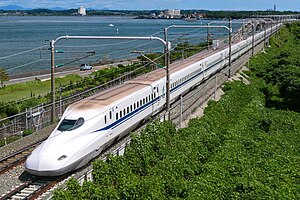
Back Shinkansen-Baureihe N700 German Shinkansen Serie N700 Spanish Shinkansen série N700 French Sinkanszen N700-as sorozat Hungarian Shinkansen seri N700 ID Shinkansen Serie N700 Italian 新幹線N700系電車 Japanese 신칸센 N700계 전동차 Korean Shinkansen Siri N700 Malay Séries N700 - Shinkansen Portuguese
| N700 series | |
|---|---|
 N700 series set F20 on the Tōkaidō Shinkansen, September 2021 | |
| In service | 1 July 2007 – present |
| Manufacturer | Hitachi, Kawasaki Heavy Industries, Kinki Sharyo, Nippon Sharyo |
| Replaced | 300 series, 500 series,[1] 700 series |
| Constructed | 2005–2020 |
| Scrapped | 2019– |
| Number in service | 2,624 vehicles (179 sets) (as of 1 April 2022[update]) |
| Number preserved | 3 vehicles (N700-9000 series) |
| Number scrapped | 13 vehicles (N700-9000 series); 352 vehicles (22 sets. of which, 1 due to fire damage) |
| Successor | N700S Series Shinkansen |
| Formation | 16 cars per trainset (8 cars per trainset for N700-7000/8000) |
| Capacity | Tokaido/Sanyo 16-car sets (F, G, K/N, X/Z): 1,323 (200 Green + 1,123 ordinary) Sanyo/Kyushu 8-car sets (R, S): 546 (24 Green + 522 ordinary) |
| Operators |
|
| Depots | Tokyo, Hakata, Osaka, Kumamoto |
| Lines served | Kyushu Shinkansen, Tōkaidō Shinkansen, San'yō Shinkansen, Hakata-Minami Line |
| Specifications | |
| Car body construction | Aluminium |
| Car length | 25 m (82 ft 0 in) (intermediate cars) 27.35 m (89 ft 9 in) (end cars) |
| Width | 3.36 m (11 ft 0 in) |
| Height | 3.6 m (11 ft 10 in), (middle cars and connectors of end cars) (without rooftop equipment) 3.5 m (11 ft 6 in) (end cars excluding connector with middle cars) |
| Maximum speed | 285 km/h (177 mph) (Tokaido) 300 km/h (186 mph) (Sanyo) 260 km/h (162 mph) (Kyushu) |
| Weight | 715 t (16-car set)[2] |
| Traction motors | 56 x 305 kW (409 hp) |
| Power output | 17.08 MW (22,905 hp) |
| Acceleration | 2.6 km/(h⋅s) (1.6 mph/s) |
| Electric system(s) | 25 kV 60 Hz AC catenary |
| Current collector(s) | Pantograph |
| UIC classification | 2'2'+14*Bo'Bo'+2'2' (N, Z and G sets) 8*Bo'Bo' (R and S sets) |
| Braking system(s) | Pneumatic, regenerative |
| Safety system(s) | ATC-NS, KS-ATC (R and S sets only) |
| Track gauge | 1,435 mm (4 ft 8+1⁄2 in) standard gauge |
| Notes/references | |
This train won the 51st Blue Ribbon Award in 2008. | |
The N700 series (N700系, Enu nanahyaku-kei) is a Japanese Shinkansen high-speed train with tilting capability developed jointly by JR Central and JR West for use on the Tōkaidō and San'yō Shinkansen lines since 2007, and is operated by JR Kyushu on the Kyushu Shinkansen line.
N700 series trains have a maximum speed of 300 km/h (186 mph), and tilting of up to one degree allows the trains to maintain 270 km/h (168 mph), even on 2,500 m (8,202 ft) radius curves that previously had a maximum speed of 255 km/h (158 mph). Another feature of the N700 is that it accelerates more quickly than the older 700 series Shinkansen trains, with a maximum acceleration rate of 2.6 km/h/s (0.72 m/s2). This enables it to reach 270 km/h (170 mph) in only three minutes. Further advancements led to the development of the N700A, an incremental evolution of the N700. N700A trains can reach 285 km/h (177 mph) on 3,000 m (9,843 ft) curves, allowing the maximum operating speed on the Tōkaidō Shinkansen to be raised to 285 km/h (177 mph). All N700 series sets have been retrofitted with most of the improvements added to the N700A series, and are now classified as "N700A".
Because of these improvements, trains can travel between Tokyo and Osaka on a Nozomi run in as little as 2 hours and 22 minutes on the fastest service (8 minutes faster than before).
A new train, the N700S, entered service in 2020 with plans to eventually replace all N700-series trains. The first four sets began operation on 1 July 2020.
- ^ Nakajima, Yoshikatsu (13 June 2018). "Epic journey of 500 Series, bullet train with a nose for adventure". asahi.com. The Asahi Shimbun. Archived from the original on 10 September 2019. Retrieved 4 January 2019.
- ^ "N700系量産車" [N700 series production trains]. Japan Railfan Magazine (in Japanese). No. 556. Japan: Koyusha Co., Ltd. August 2007. pp. 13–20.
© MMXXIII Rich X Search. We shall prevail. All rights reserved. Rich X Search